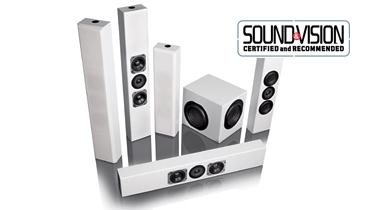Totem Tribe theater speakers with Storm subwoofer

| The Short Form |
| $7,000 (as tested) / TOTEMACOUSTIC.COM / 514-259-1062 |
| Snapshot |
| A dynamic-sounding on-wall speaker system that artfully straddles the line between domestic acceptability and audiophile-grade performance |
| Plus |
| • Big, powerful sound for slim, wall- hugging speakers • Compact but potent subwoofer • Exceptional construction quality • Tribe speakers sized to match flat- panel TVs |
| Minus |
| • Requires a powerful amp for best results |
| Key Features |
| • Tribe III ($1,500 each): ¼-in dome tweeter, (2) 4 ½-in "Torrent" woofers; 36 in high, 30 lb • Tribe I ($750 each): ¼-in dome tweeter, (2) 4 ½-in woofers; 14 in high, 26 lb • Storm ($1,000): 8-in woofer, (2) 8-in passive radiators, 300-watt amplifier; 11 x 12 x 13 3?8 in, 35 lb |
Just a few years ago, people seemed much more willing to surrender their living space to bulky audio and video gear. But when TVs began to morph from huge boxes into wall-hugging visions of sleekness, most people's tolerance for floor-space-robbing speakers waned.
Almost every custom-installed home theater uses in-wall or ceiling speakers that all but disappear from view. But the acoustic performance of in-walls is unpredictable at best, and in some rooms, the location of wall studs makes it impossible to place them for optimal performance. For many situations, on-wall speakers are a better option because they provide consistent audio performance along with good placement flexibility. The main catch is that the slender and inconspicuous design of most on-walls means they have to be partnered with a subwoofer to deliver full-range performance.
Canada's Totem Acoustic has gained an enviable reputation for making speakers that can conjure huge bass from tiny enclosures, so if anyone should be capable of delivering satisfying sound from a slim, wall-mounted model, it's them. The company's Tribe series is made up of three models - Tribe I, II, and III - that vary primarily in cabinet height, with the taller Tribe II and III models providing additional bass extension.
All three Tribes share the same driver lineup: a pair of 4½-inch long-throw woofers closely flanking a 1¼-inch soft-dome tweeter. While the tweeter remains constant across the range, the Tribe III model steps up to a pair of "Torrent" extra-heavy-duty woofers that nearly double the speaker's power-handling ability. Unusual for on-walls, the Tribes have dual pairs of high-quality binding posts neatly recessed into the cabinet's back, allowing you to biwire or biamp them. Each speaker comes with a simple wall-mounting plate, along with a color-coordinated grille that attaches to it using hidden magnets.
The Tribes have been designed to sonically match each other, so you can combine models to create a multichannel system that fits your needs. I used the top-of-the-line Tribe III across the front three channels and assigned a pair of Tribe I speakers for the less taxing surround-channel duties. Rounding out the bass was Totem's tiny Storm, a subwoofer that packs an 8-inch driver along with a pair of similar-sized passive radiators and a 300-watt amp into just over 1 cubic foot.
SETUP
The Tribe I, II, and III have been proportioned to match 42-, 50-, and 60-inch flat-panel TVs, respectively, and each is available in black, silver, or white. Still, I'd fight the temptation to mount the left and right speakers directly flanking the TV, since keeping them spread farther apart will usually result in a much more spacious sound. I ended up with two Tribe IIIs mounted on the wall about 8 feet apart, with the third placed on its side directly under my projection screen's midpoint to serve as the center speaker. I positioned the Tribe I pair against the side walls about a foot behind my listening chair, but because of their tall cabinets, I set them about 4 feet off the floor - a little lower than normal. All Tribes have ports on both end panels; care should be taken to ensure that these aren't blocked.
The Storm sub comes in black ash, gloss white, or mahogany finish (there's also cherry or maple for $100 more). The Storm worked well in the front left corner of my room when turned to 45° so that the active driver faced into the room while the passive radiators fired along the front and left sidewalls. A crossover bypass is provided, along with a continuously variable phase control and an input-level adjustment. With an Integra DTR-8.8 receiver handling the bass management, I set up a 60-Hz crossover point for the three front speakers, and 80 Hz for the surrounds. If your processor doesn't provide this same level of flexibility, I would try 80 Hz for all channels.








































